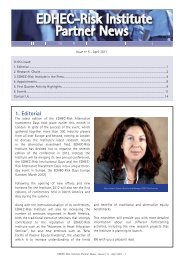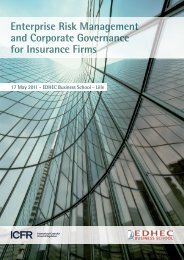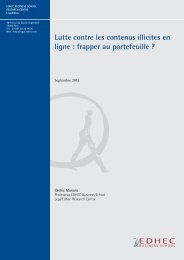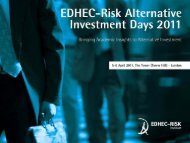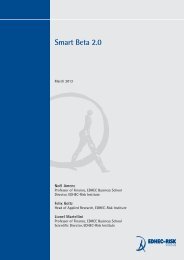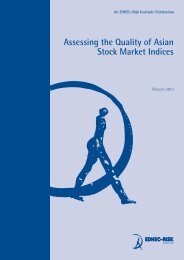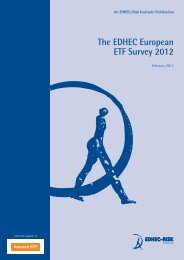The Smart Beta 2.0 Approach - EDHEC-Risk
The Smart Beta 2.0 Approach - EDHEC-Risk
The Smart Beta 2.0 Approach - EDHEC-Risk
Create successful ePaper yourself
Turn your PDF publications into a flip-book with our unique Google optimized e-Paper software.
An ERI Scientific <strong>Beta</strong> Publication — <strong>Smart</strong> <strong>Beta</strong> <strong>2.0</strong> — April 2013<br />
Copyright © 2013 ERI Scientific <strong>Beta</strong>. All rights reserved. Please refer to the disclaimer at the end of this document.<br />
17<br />
1. <strong>The</strong> <strong>Risk</strong>s of <strong>Smart</strong> <strong>Beta</strong> Strategies<br />
Exhibit 6: Overview and Specific <strong>Risk</strong> of Popular Equity Weighting Schemes – <strong>The</strong> table indicates, for a range of smart beta strategies, the weighting<br />
scheme used, the required parameters, and the relevant foundation paper. <strong>The</strong> column “Optimality conditions” indicates under which conditions<br />
each diversification strategy would result in the Maximum Sharpe Ratio portfolio of Modern Portfolio <strong>The</strong>ory. N is the number of stocks, µ i is the<br />
expected return on stock i, σ i is the volatility for stock i, ρ ij is the correlation between stocks i and j, µ is the (Nx1) vector of expected return, 1 is the<br />
(Nx1) vector of ones, σ is the (Nx1) vector of volatilities, Ω is the (NxN) correlation matrix and Σ is the (NxN) covariance matrix. Please refer to the<br />
Appendix for a brief presentation of each strategy.<br />
Strategy<br />
Market Cap Weights (CW)<br />
Diversity Weights (DW)<br />
Weighting<br />
scheme<br />
**<br />
Required<br />
parameter<br />
Observable market cap<br />
information<br />
Observable market cap<br />
information<br />
Foundation<br />
paper<br />
Sharpe (1964)<br />
Fernholz and Shay<br />
(1982)<br />
Optimality<br />
conditions<br />
CAPM<br />
assumptions<br />
+ no other assets*<br />
Unclear<br />
Fundamental Weights (FW)<br />
***<br />
Unobservable<br />
accounting information<br />
Arnott, Hsu<br />
and Moore (2005)<br />
Unclear<br />
Max Deconcentration (MD) / Equal<br />
Weights (EW)<br />
<strong>Risk</strong> Parity (RP) also known as Equal <strong>Risk</strong><br />
Contribution (ERC)****<br />
None<br />
DeMiguel, Garlappi<br />
and Uppal (2009)<br />
µ i = µ<br />
σ i = σ<br />
ρ ij = ρ<br />
σ i , ρ ij Maillard et al. (2010) λ i = λ<br />
ρ ij = ρ<br />
Diversified <strong>Risk</strong> Parity (DRP) σ i Maillard et al. (2010) λ i = λ<br />
ρ ij = ρ<br />
Maximum Diversification Ratio (MDR) σ i , ρ ij Choueifaty and<br />
Coignard (2008)<br />
Global Minimum Variance (GMV) σ i , ρ ij MPT (many papers<br />
following Markowitz,<br />
1952)<br />
Max Decorrelation (MDC) ρ ij Christoffersen<br />
et al. (2010)<br />
λ i = λ<br />
µ i = µ<br />
µ i = µ<br />
σ i = σ<br />
Diversified Minimum Variance (DMV) σ i N/A µ i = µ<br />
ρ ij = 0<br />
Maximum Sharpe Ratio (MSR) µ i , σ i , ρ ij MPT (many papers<br />
following Tobin, 1958)<br />
Optimal by<br />
construction<br />
*CAPM assumptions imply that the true market portfolio CW is an efficient portfolio. For a given CW equity index to be efficient, the CAPM<br />
assumptions are therefore not enough; one also needs to assume that the equity index is the true market portfolio, that is one needs to assume away<br />
the existence of any asset other than the constituents of the stock index under consideration.<br />
**0 ≤ p ≤ 1. If p = 1, DW is similar to CW and if p = 0, DW is similar to EW.<br />
***Here s=(s 1 ,..., s N ) is a vector containing for each stock some fundamental accounting measure of company size.<br />
****Here the beta β=( β 1 ,..., β N ) is the vector of betas with respect to the RP portfolio, hence portfolio weights for the RP portfolio appear on both sides<br />
of the equation, which needs to be solved numerically (no analytical solution).<br />
In this area, we also wish to stress that it is not because a methodology claims to be a common<br />
sense approach and aims not to be "quantitative" that optimality risk and parameter estimation<br />
risk do not exist. On the contrary, the further removed one is from the academic mainstream<br />
when proposing ad-hoc models based on intuition, the greater the risk that the model chosen was<br />
selected for its performance over the back-test period. As such, fundamental weighting schemes




